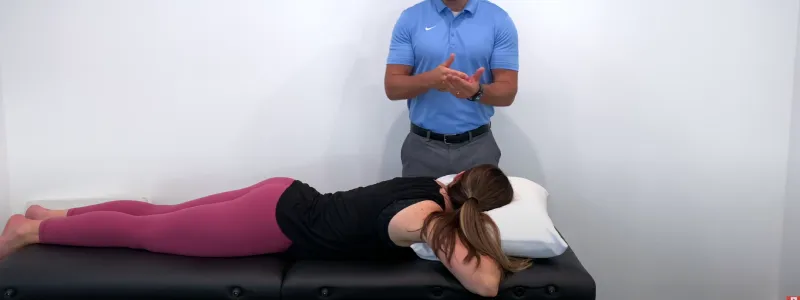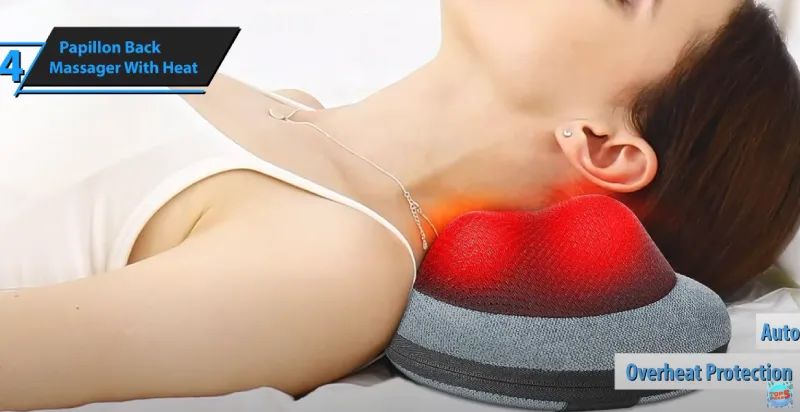If you prefer to sleep on your side, ensure your pillow is an excellent height to support the neck. Place a pillow between your knees to keep your spine in a better position and support your lower back. Avoid lying directly on the bitter side if you have a sore shoulder.
Grinch agrees that sleeping on your back could work for many cyclists to avoid aches, as it allows the hips, lower back, and neck to stretch out, offering riders a different position than what they maintain on the bike.
In this comprehensive guide, we’ll go through some of the best sleeping positions, pillows, mattresses, and other products to help you manage neck and shoulder pain as a cyclist.
Yoga Poses for Neck & Shoulder Pain for Cyclists: 4 Routines

The aftermath of a long ride can sometimes lead to painful neck and shoulder muscles. To help alleviate the discomfort of a painful neck and allow for a good night’s rest, it’s essential to understand how to sleep correctly. We’ll explore the best sleeping positions for those with neck and shoulder pain and how cyclists can adapt them for maximum relief.
Back Sleeping for Cyclists
The best position for sleeping is on your back to relieve sore neck and shoulder pain. For cyclists, it may only sometimes be the most comfortable position due to the tendency to snore or suffer from sleep apnea. Sleeping on your back is also the best position for cyclists with torn rotator cuffs. Here are some tips for back sleeping that can help to reduce shoulder and neck pain after cycling.
Choosing the Right Pillow and Using Shoulder Support: Choose a medium-firm or firm pillow to support the head and neck, and place a small pillow or rolled-up towel under the shoulders for added support.
Alternatives for Snorers and Sleep Apnea Sufferers: Elevate the head with an adjustable bed or pillow, or try a wedge-shaped pillow to open airways and reduce snoring and sleep apnea symptoms.
Side Sleeping for Cyclists
Another recommended position against neck and shoulder pain is side sleeping. When done correctly, this position can help alleviate pressure on the neck and allow for a more comfortable sleep. Here are some tips for side sleeping:
Aligning Head and Abdominal Spine for Pressure Relief: When you lay with shoulder pain, place a firm pillow between your knees and align your head with the abdominal spine. This will relieve pressure on the neck while you lie down without hurting.
Selecting the Proper Pillow Height and Using Leg and Arm Support: Use a thick pillow under the head and prevent it from tilting, and place a folded towel under the arm for additional support.
Avoid Overloading One Shoulder and Protecting the Chin: Place a pillow under one shoulder to prevent shoulder sagging and limit pressure points, and tuck the chin slightly to avoid straining the neck.
Stomach Sleeping for Cyclists
Stomach sleeping is generally not recommended in cases of neck pain due to the risk of forced neck rotation and pressure on neck joints. Also, sleeping with the stomach is very grateful for scopula pain. However, if you must sleep on your stomach, here are
some tips for doing so more comfortably:
Forced Neck Rotation and Neck Joint Pressure: Avoid turning the head to the side or using multiple pillows, as this can strain the neck and create additional pressure on the joints.
Tips for Using a Very Thin Pillow for Forehead Support: Use a skinny pillow for forehead support only to help keep the neck and spine more aligned and prevent discomfort.
Neck and Shoulder Pain Sleep For Cyclist: Best Products
Investing in the right products is one of the most effective approaches to alleviating neck and shoulder pain. The products can contribute to reducing discomfort and facilitating better sleep. We will explore the best products for neck and shoulder pain relief and provide you with essential tips on choosing and maintaining them over time.
Pillows

Pillows are crucial in promoting spinal alignment, reducing pressure points, and easing tension in the neck and shoulder muscles. Finding the right pillow can be challenging, but it is essential to consider some criteria to ensure that you choose the best option for your sleeping position. The following are some elements to keep in mind:
- Firmness: The pillow should be firm enough that the head and neck are supported adequately, but it should not feel too hard or soft.
- Loft: The pillow’s height (or its loft) depends on your sleeping position. Back sleepers may benefit from a thinner pad, while side sleepers need a higher loft to align the neck with the spine.
- Material: Pillows can be made of various materials, such as memory foam, latex, down feathers, or synthetic fibers. Each material has advantages and disadvantages, depending on your preferences and needs.
- Shape: Some pillows, such as cervical or U-shaped ones, are designed in specific conditions or contours that can support the neck and shoulders
Once you have chosen the right pillow, you must ensure that it lasts longer and remains hygienic. You should wash your pillow regularly (depending on its material and manufacturer’s instructions) and replace it every 1-2 years when it loses shape or feels uncomfortable.
Mattresses
The mattress is another critical factor that can affect your neck and shoulder pain, as it provides the primary support for your body during sleep. A good mattress should distribute your weight evenly, align your spine, and relieve pressure points. Here are some factors to consider when choosing a mattress:
- Firmness: Like pillows, mattresses have various firmness levels, from soft to firm. The ideal firmness depends on your body weight, sleeping position, and personal preference.
- Support: A good mattress should provide adequate support for your body, especially in the lower back and hips.
- Material: The type of mattress can influence its durability, comfort, and breathability. Some popular materials include memory foam, latex, innerspring, or hybrid (a combination of foam and coils).
- Size: Your mattress should be spacious enough to move freely and change sleeping positions without feeling cramped.
As with pillows, mattress maintenance is essential for its longevity and hygiene. You should vacuum your mattress regularly, rotate or flip it every few months, and replace it every 7-10 years when it loses its support or shows signs of wear and tear.
Other Products

In addition to pillows and mattresses, several complementary products can help alleviate neck and shoulder pain stress and promote relaxation. Some of these products include:
- Neck massagers or pillows: These devices can provide heat, vibration, or pressure to target sore muscles in the neck and shoulders.
- Eye masks or earplugs: Blocking out light and noise can help you sleep better.
- Essential oils or aromatherapy diffusers: Certain scents can be calming and enhance sleep quality.
- Yoga mats or foam rollers: Practicing yoga or self-massage can improve flexibility, reduce tension, and strengthen the muscles.
- Helmet: The choice of helmet can greatly impact your comfort. It envelops your neck like a collar, with adjustable straps ensuring a secure fit. Adequate ventilation maintains a cool temperature, warding off muscle tension.
Using these products safely and cautiously is crucial, especially if you have any underlying medical conditions, allergies, or sensitivities. You should consult your doctor before using any new product that may interact with your medications or cause side effects.
Sleep With Painful Shoulders And Neck For Cyclists: Best Exercise
Bicyclists often experience neck and shoulder pain. But the good news is, there are exercises that can help ease this discomfort, especially when it’s time to sleep. Exercising helps stretch and strengthen muscles, providing relief and promoting better sleep.
Gentle Neck Stretches
- Side Neck Stretch: Sit or stand up straight. Gently tilt your head towards one shoulder until you feel a light stretch on the opposite side of your neck. Hold for 15-20 seconds, then repeat on the other side.
- Forward and Backward Tilt: Slowly nod your head forward, bringing your chin towards your chest. Hold for a few seconds. Then, gently tilt your head back to look up at the ceiling. Hold again for a few seconds.
Shoulder Exercises
- Shoulder Rolls: Lift your shoulders towards your ears, then roll them back as you push them down. Repeat this movement in a fluid motion for about 30 seconds. This helps relieve the tension built up from cycling.
- Arm Circles: Extend your arms out to the sides at shoulder height. Slowly make small circles with your arms, gradually increasing the size of the circles. After 30 seconds, switch directions.
Strengthening Exercises
- Wall Push-Ups: Stand arm’s length away from a wall. Place your palms on the wall at shoulder height. Bend your elbows and lean your body towards the wall, then push back to start. This strengthens the shoulder muscles without straining them.
- Doorway Stretch: Stand in a doorway with your arms out to the side, elbows bent at a 90-degree angle, with both hands on the door frame. Gently lean forward until you feel a stretch in your shoulders and chest. Hold for 15-20 seconds.
Regularly doing these exercises can help alleviate cyclists’ neck and shoulder pain. Start slowly, increase intensity comfortably, and consult a healthcare provider if needed.
Conclusion
Cycling can be a source of great joy and adventure, but it can also come with discomfort, particularly if you need to care for your body’s alignment and posture. Back and neck pain are common complaints among cyclists, making it hard to enjoy a good night’s sleep. Manage this pain and sleep better with the correct information and tools.
We hope this guide has helped you choose pillows, mattresses, and sleeping positions that suit your needs and preferences. Remember that everyone’s body is different, so don’t hesitate to experiment and adjust until you find what works for you.
FAQs
How Does Cycling Affect Shoulder Impingement?
Cycling can influence shoulder impingement in various ways, with impacts ranging from positive to negative based on factors like bike fit, riding posture, and the impingement’s severity. Shoulder impingement arises when the rotator cuff tendons or bursa in the shoulder to get compressed or irritated, resulting in pain, inflammation, and restricted range of motion.
How Does Cycling Posture Affect My Sleep?
Yes. Holding the handlebar in an uncomfortable position for an extended period can cause muscle tension, cramps, and inflammation. Consequently, this can lead to pain and discomfort during sleep.


